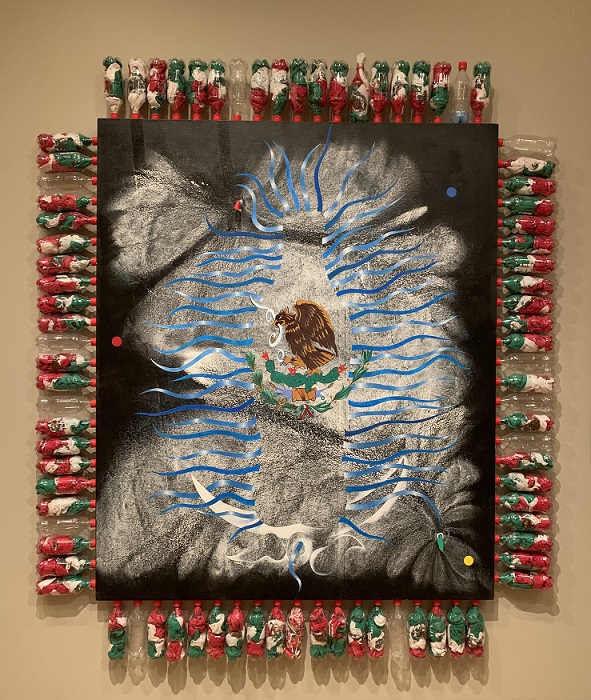
Rafael Perea de la Cabada
Mexican, 1961-
Agua bendita (Holy Water), 2000
acrylic and mixed media on canvas, plastic bottles, cloth, and metal
89 1/2 × 77 1/2 in.
SBMA, Museum purchase with funds provided by the 20th Century Art Acquisition Fund
2000.43

Rafael Perea de la Cabada, undated photo, SBCC
"I believe the artist’s function in society is to act as an agent of change and renewal, revealing the unseen and making uncommon the common. Art proposes new ways of activating what is stagnant and helps us perceive anew the mundane and unearth the timeless." - Rafael Perea de la Cabada
RESEARCH PAPER
"The subject of the work is the powerful presence and influence of multinational corporations in Mexico. What is implied is that Coca-Cola, in a way, has become a holy icon, like the Virgin of Guadalupe." - Rafael Perea de la Cabada
"Agua bendita" (Holy Water) was completed in 2000 by Rafael Perea de la Cabada, a Mexican artist who has lived in Santa Barbara since 1987. In this mixed media work, the artist juxtaposes three iconic images - the Mexican flag, the Virgin of Guadalupe, and the Coca-Cola bottle - to suggest complex connections between the three most powerful forces shaping Mexico: the government, the Church, and multi-national corporations.
At the center of the canvas is the eagle and serpent emblem from the Mexican flag. According to legend, the gods advised the Aztec people that they would know the site on which they should establish their city when they saw an eagle, perched on a prickly pear tree, devouring a serpent. After many years of wandering, the Aztecs came upon this mythical eagle on a marshy lake, where they built their great city. Today the site is the main plaza in Mexico City. This central image, then, represents both the Mexican government and lost Aztec empire. Closer inspection of "Agua bendita's" eagle reveals that it holds in its beak not the serpent, but the unfurling ribbon of the Coca-Cola logo.
Depicted behind the eagle and serpent is the iconic image of the Virgin of Guadalupe, the patron saint of Mexico and its most powerful Catholic symbol. Her image appears everywhere in Mexico: in churches, at roadside shrines, on t-shirts, decals on the backs of buses, and banners carried in the streets by political insurgents. In 1531, only ten years after the Spanish conquered the Aztecs, The Virgin of Guadalupe revealed herself to Juan Diego, an Aztec who had been baptized by Catholic missionaries. She was beautiful, dark skinned, and spoke to Diego in his native Nahuatl language, declaring herself to be the Virgin Mary. Her distinct image later appeared on his cape (and is clearly visible today, displayed 400 years later in her Basilica). News of this miracle spread quickly throughout the Aztec population, and was undoubtedly the single most important factor enabling Spanish missionaries to hasten mass conversion of the indigenous population to Catholicism after the conquest. The Virgin, then, represents two ironically opposed forces in Mexico; the Church, possessor of enormous political power and wealth throughout Mexican history, and the poor peasant population for whom the Virgin is revered protector and symbol of hope.
In "Agua bendita" we recognize the Virgin of Guadalupe by the rays of light emanating from her form, and the crescent on which she stands. Her body is shown in negative space, but closer observation reveals that her contour forms the outline of a Coca-Cola bottle. Half of the crescent beneath her is depicted in negative space, and the image of the angel beneath her feet is reduced to a few abstract shapes. Perea de la Cabada has altered the aura of light surrounding her from the traditional yellow with straight lines emanating outward, to blue ribbon-like rays, which suggests the “holy water" of the title, as well as the written script and the wavy design pattern of the Coca-Cola logo. Below the crescent, in place of the angel's head, one of the Virgin's blue rays slithers out toward us through a small painted circle, just as the tip of the “C” moves through the "l" in the Coca-Cola logo. This element is repeated in the tips of green and red handkerchiefs emerging from the canvas through grommets, and in one white corner of a handkerchief rising out from a plastic Coke bottle.
The Coca-Cola imagery represents the presence and influence of multi-national corporations in Mexico, a long-standing, deeply contentious political issue. The Coca-Cola bottle also alludes to Vicente Fox, the former CEO of Coca-Cola Latin America, who was elected President of Mexico in 1999. Fox campaigned on the promise of change in Mexico, and his election marked the end of a 71-year reign of power by PRI, the Institutional Revolutionary Party. The eagle/serpent emblem of the government and the Coca-Cola imagery combine to represent Fox and the political future of Mexico.
Perea de la Cabada is interested in the power of iconic images. He superimposes the three iconic symbols of Mexican power, one on top of the other, in the very center of his canvas, and mixes them in a way that causes the viewer to question their meaning. Is Coca-Cola the new “holy water” in Mexico? Perea de la Cabada has said that, as the real thing, Coke may quench the thirst, but only temporarily, and is in reality unhealthy. In connecting the Virgin of Guadalupe with Coca-Cola, he asks if she is the real thing. Does she provide a sustaining spiritual connection for the people, or just another temporary fix, mere sugar water? He applies the same questions to President Vicente Fox. Is he another “product,” packaged and sold to the Mexican people to win the election? Will he successfully generate change in Mexico, or is he merely an image, devoid of substance? Perea de la Cabada underscores the Virgin of Guadalupe's iconic stronghold on the Mexican psyche by suggesting only her outline, knowing that the viewer will compose the rest. Three dots painted in primary colors form a triangle around the central images echoing the theme of “Mexican trinity:” Government, Church, and multi-national corporations.
Perea cle la Cabada has indicated that the plastic Coke bottles framing the work compare to bodies of Mexican migratory workers, who are used, recycled, and discarded by both the United States and Mexico. “Stuffed inside the bottles are handkerchiefs dyed to resemble Mexican flags. The flags represent the Mexican heritage and national pride that migratory workers carry ‘bottled up” inside. Handkerchiefs absorb their sweat and tears. The artist's notes indicate that the bottles are arranged in a way that is numerically precise and symbolically meaningful, but often only to him. Seventy-one of the bottles contain the dyed handkerchief/flags, reflecting the seventy-one years the PRI held power in Mexico. The white handkerchief corner sticking out of bottle on upper edge represents hope.
Perea de la Cabada emphasizes that all of his work evolves through the art-making process. “Like a writer who has a thought, it remains just a thought until it is conveyed, until it is put into words. The process of a work of art is as essential as the statement it is making." For Perea de la Cabada, the beginning of a work is connected to the organic process of how the materials behave. After he prepared the surface of the canvas for "Agua bendita", the painting began to take shape out of an accumulation of ideas, memories, information and sketches, many of which he had recorded over the years in a series of journals. He notes that it was not his original intention to depict the Virgin. “I noticed the similarity of her shape to the Coke bottle and made the connection that there is no way to alter these images, they are so deeply ingrained.“ He sees the canvas as a skin which, like human skin, communicates through its orifices, openings and pores. The grommets in "Agua bendita" serve as orifices ... possibly breeding orifices. The work took shape gradually over a period of three years. The idea of framing the canvas with Coke bottles came to him in his studio when a friend dropped by and set his soda bottle on the upper rim of the canvas.
"Agua bendita" reflects the art of the Mexican muralists in its interest in contemporary political issues, but with a difference. Perea de la Cabada states: In “Portrait of Mexico Today", Siqueiros directly criticizes Calles, Mexico's ex-president, portraying him in disguise, as a thief. In "Agua bendita", I am more subtle. I am also referring to a political facade, to promises unfulfilled; the empty space is a metaphor for social change still waiting to happen.
Perea de la Cabada is also influenced by the generation of artists that followed the muralists, including Tamayo and Gerszo, who left political art behind: I developed my work at a time when there was a generational divide between artists. On the one hand, there were those who followed in the footsteps of the muralist movement, who viewed art as a weapon or tool for social change, capable of indoctrinating and mobilizing people. On the other hand were the artists who believed in the universality of art and subscribed to a more personal, poetic and lyrical visual language, independent of political affiliation. "I was influenced by both currents, the extremes and the grays in between. Art and life are two sides of the same coin - I cannot separate them." Rafael Perea de la Cabada hopes his painting raises more questions than answers, and does not mind if people bring their own interpretations to his work. He wants it to create an interest in Mexican culture and history, and wants viewers to enjoy the experience. “'Agua bendita' is not an illustration of a thought, but rather an invitation to observe, reflect and consider the symbols within the painting."
Submitted by Yadi Zeavin, March 29, 2001
SBMA CURATORIAL LABELS
In “Agua bendita”, Santa Barbara-based artist Rafael Perea de la Cabada blurs religious and cultural symbols of contemporary Mexico in an allegory to political change. The work’s central image doubles as a bottle of Coca-Cola and the Virgin of Guadalupe, while also referencing the central emblem of the Mexican flag. Surrounding these intertwined icons are plastic Coke bottles filled varyingly with handkerchiefs emblazoned with the Mexican flag. Having created this work after former CEO of Coca-Cola for Latin America, Vicente Fox, was elected President of Mexico, Perea de la Cabada alludes to the polarities that make up Mexican society and the frequent conflation of politics, cultural identity, and consumerism.
- Ridley-Tree Rotation, 2019
